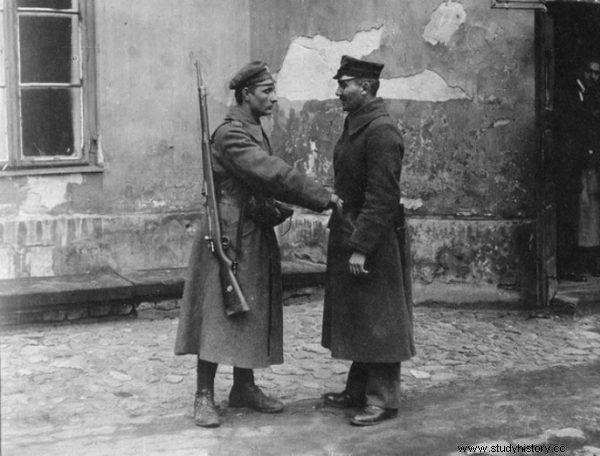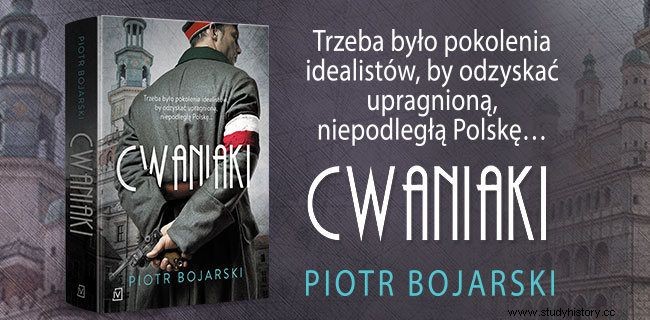In Warsaw and the entire Kingdom of Poland, the Germans were disarmed even before November 11. It was happening without plan or direction, spontaneously, on the wave of enthusiasm engulfing the nation. There were even exchanges of fire in some places. How many Polish victims did this breakthrough month claim?
Euphoria intertwined with chaos. The first days and even weeks of independent Poland can be described with these very words. At a time when fierce disputes and discussions about the shape of the state were taking place, German troops were still in Warsaw. It was similar in Krakow and the whole of Western Galicia, where the Poles had to deal with the Austrians.
In some parts of Poland, removing and disarming the partitioning administration required only strong pressure. The Austrians withdrew practically without major losses on the Polish side. Soon they were displaced from cities such as Kraków, Lublin, Dęblin and Kielce. Unfortunately, the evacuation of the Germans from the territory of the Kingdom of Poland did not go so smoothly.
Liberate Warsaw
When Józef Piłsudski returned to Warsaw, he found chaos in the capital. Disputes over power in the country continued, and the joy of liberation was still sprinkled with uncertainty. In addition, thousands of German soldiers were still stationed in the city. Demoralized by defeat in the war, but still armed, they posed a threat to independent Poland.

Disarming a German soldier in Warsaw. November 1918.
Piłsudski realized that appropriately incited people would be willing to bring justice to the former occupiers. However, he wanted to avoid casualties and another war. Meanwhile, he did not even get a good night's sleep after an exhausting journey from Berlin, when a delegation from the German Soldiers' Council had already visited him. The marshal later recalled:
When I was surprised by this delegation what they might want from me, they said that they were ready to submit to all my orders, so that I would guarantee them their life and free departure to their homeland.
In return for the possibility of leaving Warsaw safely the Germans were asked to hand over telephone and telegraph communication, a railway park and military equipment with weapons . The former occupiers agreed to this pact. In practice, disarming them turned out to be much more difficult. Although the atmosphere of hostility towards the partitioning powers calmed down somewhat, incidents continued to occur.
Despite these complications, on November 11, a representative of the former occupation army was rarely seen on the streets of Warsaw. It was not without bloodshed, however. The balance of Polish losses in Warsaw until November 12 was 10 fatal and 30 wounded. Worse still, the problem with disarming the Germans in the capital has not been fully resolved at all. 8,000 soldiers took the Citadel, expressing their readiness to fight the Poles.

This article was inspired by a novel by Piotr Bojarski entitled "Cwaniaki" . Describing, inter alia, the events of November 1918.
A similar situation developed in Jabłonna near Legionowo. The German soldiers stationed there did not want to hand over their weapons to the Poles, fearing that despite the agreement between the Council and Piłsudski, they would be murdered. It could also be significant for them that they treated the return home unarmed as an insult to their honor. During disarmaments, carried out by, among others, soldiers of the Polish Military Organization, incidents and exchanges of fire took place more than once. Individual Poles died as a result of the fighting.
Piłsudski decided to react, all the more so because at the same time he was also receiving information from other parts of the former Kingdom about problems with the peaceful transfer of weapons. Meanwhile, the country was plunging into political chaos. Ultimately, the Germans were allowed to leave Warsaw, keeping their weapons - they were ordered to hand them over only at the border stations. This calmed the tense atmosphere, although even then, during the liberation of the Citadel by the crew of the former invaders, there was an exchange of fire.
The subsequent evacuation went smoothly and without casualties. On November 19, the last German soldiers left the capital. In total, about 30,000 of them left. Outside of Warsaw, however, the situation was much more difficult.
Bloody Disarm
Disarmament in Łódź was carried out spontaneously and as a result of national demonstrations. Unfortunately, it was not without fatalities. As a result of the clash on Konstantynowska Street, several Poles and Germans were killed. In turn, during the attack on the Fabryczna Railway Station, the occupiers stabbed the soldier Bolesław Sałaciński to death with bayonets . In total, the losses on the Polish side in the city amounted to 5 people. On November 13, a solemn funeral was organized for them. The coffins of the fallen carried tens of thousands of people in turns.

Members of the Polish Military Organization in Częstochowa in the photo from November 1918.
The disarmament of the occupant in Częstochowa was also spontaneous. Not only the military, but also the civilian population participated in this project. In the evening of November 1, the bloodless process was interrupted by a fire exchange. As a result, several Poles were killed. Among them was Władysław Zagórski, son of the later MP, Józef Zagórski.
In many cities and towns, weapons were taken from the Germans efficiently and effectively. This was the case, inter alia, in Ciechanów and Kalisz. On the other hand, in Mława, 50 peowiaks were disarmed by school youth. Everything proceeded without major obstacles, until at the border with Prussia one of the German gendarmes fatally wounded Henryk Sokalski - a student of the junior high school in Mława. The funeral of the young man gathered the whole city.
In some smaller towns, the inhabitants faced more staunch resistance. In Sieradz, as many as 4 Poles died as a result of the clashes. The end of the liberation of Łomża, where the commander of the POW - Leon Łuczyński, was also tragic. Even so, the city was quickly captured.

Mainly the peers went to disarm the Germans in November 1918. The photo shows members of POW in Siennica.
The last cruelty of the Germans
There were more places where single Poles died. However, the most difficult situation arose in Międzyrzec Podlaski, where the liberation took place in a completely different way than in the rest of the Polish lands. This is where more victims fell than anywhere else in the Kingdom. These were the most dramatic incidents of November 1918.
Initially, nothing foreshadowed the impending tragedy. The inhabitants of Międzyrzec effectively disarmed the Germans and it seemed that the town was under Polish control. However, on the night of November 15/16, strong and organized German troops entered the city. One of the Poles described the moment as follows:
Suddenly a thud, the crash of a broken window. A grenade falls into the room where my son was sleeping and explodes. We hear someone knocking on the door. In a moment they fall broken. The Germans enter the house. They looked into our room, kept looking (...) After the search, I hear "You will come with us to Biała and he will be shot there" .

Monument to the victims murdered by the German army in Międzyrzec Podlaski.
The robberies, murders and repressions affected every inhabitant who was even suspected of disarming the partitioning powers. As a result of German cruelty 44 Poles lost their lives, including one 7-year-old boy . Fears that a similar fate could await other nearby towns also grew. It would be a real disaster. In the event of a counteroffensive, the divided and poorly organized defenders of Polish independence would not be able to repel tens of thousands of German soldiers. Fortunately, the prognosis finally paid off. On November 18, the Germans agreed to leave the Polish lands and give up arms at the border.
The complete withdrawal of the partitioning forces from the reborn country allowed finally to focus on the internal problems of the state. After all, the Polish nation still did not know in what shape the desired Republic of Poland would be reborn. For this peace, however, was paid dearly. Disarming the Germans cost independent Poland about 100 deaths and several hundred wounded. This was the balance of losses on November 1918.
Inspiration:
This article was inspired by a novel by Piotr Bojarski entitled "Cwaniaki" , describing, among other things, the disarming of the Germans in Warsaw in November 1918.
Buy the book at a discount on empik.com

